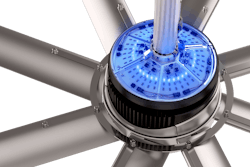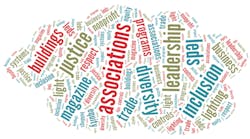There’s a school of thought among lighting companies that says LED-based UV-C is not yet up to the task of combating the coronavirus, and that conventional mercury-vapor lamps are the way to go. But don’t tell that to Big Ass Fans, or for that matter, to its LED UV-C supplier, Crystal IS.
As LEDs Magazine reported a little over a week ago, Big Ass Fans, the Lexington, KY provider of fans for commercial and home environments, has equipped some of its ceiling fans to emit UV-C radiation above the rotating blades.
We said at the time that we would provide an update if we uncovered more details of the UV-C source.
Big Ass Fans has confirmed for LEDs that it is using UV-C LEDs provided by Crystal IS, a company based in Green Island, NY, near Albany.
Crystal IS, which is owned by Japan’s Asahi Kasei, has a stable of germicidal UV-C LEDs branded Klaran and targeting pathogens including viruses, bacteria, and endospores for use in treating water, air, and surfaces. The ¥2.16 trillion (US$20.8 billion) parent firm is based in Tokyo and has a diverse portfolio that includes among other things chemicals and petrochemicals for fibers and materials; pharmaceuticals; medical diagnostics; and prefab housing.
Crystal IS has now added SARS-CoV-2 — aka the coronavirus — to its crosshairs, with emitters tuned to between 260 and 270 nm, squarely in the C band of ultraviolet radiation, which is shorter than the A and B bands, and which at certain frequencies and doses has been proven to deactivate the virus.
Big Ass Fans told LEDs that it is using Crystal IS chips set at 265 nm. The company mounts them on a circuit board, which it builds into a module it designed to fit into the ceiling fans just above the rotating blades. It slots the module into some models of its Haiku ceiling fans, which are for indoor use in places such as homes, classrooms, offices, and restaurants. Customers include Pittsburgh’s Carnegie Mellon University, which has outfitted some classrooms, and the Boca Raton, FL-based Orangetheory fitness chain, which has equipped some gyms in Colorado, Utah, and Kentucky.
The modules also include blue indicator LEDs that illuminate when the UV-C chips are switched on so users know that the air is being purified, according to Big Ass Fans.
UV-C is hazardous to skin and eyes, but Big Ass Fans states on an FAQ page that “when operated correctly, Haiku with UV-C technology is safe for your eyes.” When we asked for more detail, the company cited an Illuminating Engineering Society (IES) UV-C report on eye and skin safety noting that at a height of 2.1m (about 7 ft), “specially designed and installed UV-C fixtures” are safe. The UV-C LEDs point up at the ceiling, not down towards people at floor level, a Big Ass Fans spokesperson noted. In addition, the blue indicator lights serve as a caution, alerting maintenance people, for instance, that the UV-C is activated.
Big Ass Fans will soon add the Crystal IS UV-C technology to another line of fans called Essence, the spokesperson told us. Big Ass Fans uses the technology in some larger fans as well, for which it sometimes instead uses a non-lighting air-cleaning technology known as ionization, especially in larger spaces. (In our earlier story, we incorrectly stated that Big Ass Fans’ larger line is branded as Clean Air Systems. Clean Air is actually an umbrella term for all its fan lines, which include Haiku, Essence, AirEye, PFX, PFD, and an upcoming Black Jack).
California testing lab Innovative Bioanalysis examined Haiku for coronavirus effectiveness earlier this year and wrote to Big Ass Fans that “with regards to the aerosol testing we saw approximately a 48% reduction [of airborne SARS-CoV-2] above the fan at 5 minutes and approximately an 86% reduction above the fan at 10 minutes.” By 20 minutes the level had risen to “99.99% or greater.”
Crystal IS president and CEO Larry Felton told LEDs that the UV-C chips his company is supplying can eliminate 99.9% of SARS-CoV-2 over a period of 4‒5 seconds, according to testing conducted by the National Emerging Infectious Diseases Laboratory (NEIDL) at Boston University.
By combining an air circulation system with the virus zappers, the idea is to increase the chances of disinfecting more air in a given period of time.
“Without the airflow generating from the Haiku ceiling fan, the UV-C technology would only sanitize the air directly surrounding the UV-C fixture,” Big Ass Fans says on the FAQ section. “Operating the ceiling fan in combination with the UV-C fixture brings sanitized air down to the occupant level.”
Eric Rondolat, CEO of the world’s largest lighting company — Signify (formerly Philips) — has also talked up the benefits of boosting air circulation to abet the effectiveness of UV-C against SARS-CoV-2.
Rondolat earlier this year led Signify on a big push to add UV-C products and manufacturing capacity. The same BU lab that verified the Crystal IS UV-C LEDs earlier this year, NEIDL, also verified Signify’s mercury vapor UV-C as a coronavirus killer, at 254 nm.
In one recent deployment, an Edeka supermarket in Hamburg, Germany added thirty-one Signify 254-nm UV-C luminaires, although it did not alter the air circulation system (we do not know what state the store’s HVAC was in previously).
For all of his UV-C enthusiasm, Rondolat has insisted that the best path at the moment is with conventional mercury-vapor luminaires, such as those installed at the Edeka branch. While he has not ruled out eventually offering LED emitters, he told LEDs last June that in their current state they would require far more light sources than would be practical.
“If we were using LED, it would be totally incompatible from a cost perspective and from a consumption perspective,” Rondolat told LEDs six months ago, when he explained that LED technology would require 50× more light sources than mercury.
Around that time, Signify leader of Digital Solutions Harsh Chitale concurred with his boss, telling LEDs that “on LED at 254 nm, as of now, we see that the power that comes out is still not adequate.”
In a webcast from LEDs earlier this year, Bob Karlicek, director of the Center for Lighting Enabled Systems & Applications (LESA) at Rensselaer Polytechnic Institute (RPI) noted that UV-C LEDs could benefit from improvements in power efficiency, and was optimistic that those improvements would come.
Crystal IS and Big Ass Fans believe they are ready for prime time, with the 260‒270-nm range including the 265-nm chip that Big Ass Fans is using.
The fan company would not tell us how many UV-C chips it is building into its modules, which by photographic appearance are not unwieldy but fit neatly onto the stem of the fan.
A Big Ass Fans specification sheet shows a power input of around 22W for the module (22.4W for a 12V/1.9A version, and 21.2W for a 24V/0.9A version). Crystal IS CEO Felton told LEDs that “a typical Klaran LED consumes 3.6W at 500 mA, so a 2% wall-plug efficiency.” The 4‒5-second killing time entails a dose of 5 mJ/cm2, he said.
The UV-C LEDs do not have the super-long lifetime associated with visible white-light LEDs. They are rated to last 9000 hours, according to the FAQ, although it’s not clear how long they maintain their full strength over that period.
“The Haiku UV-C fixture can be replaced at any time to maintain maximum operational efficiency,” Big Ass Fans states. “The rated life for Haiku UV-C diodes is about 9000 hours, or about 375 days of continuous use.” It is selling replacement UV-C modules for $250. Pricing for a UV-C equipped Haiku fan starts at $1744, compared to $1244 without UV-C.
MARK HALPER is a contributing editor for LEDs Magazine, and an energy, technology, and business journalist ([email protected]).
For up-to-the-minute LED and SSL updates, why not follow us on Twitter? You’ll find curated content and commentary, as well as information on industry events, webcasts, and surveys on our LinkedIn Company Page and our Facebook page.






